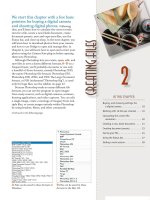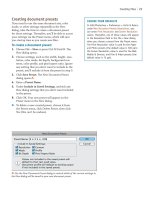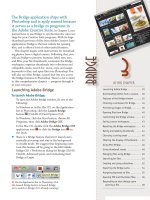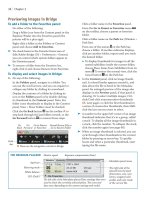Sử dụng photoshop cs5 part 10 pdf
Bạn đang xem bản rút gọn của tài liệu. Xem và tải ngay bản đầy đủ của tài liệu tại đây (690.4 KB, 6 trang )
ptg
camera raw
IN THIS CHAPTER
Why use Camera Raw? . . . . . . . . . . . 59
Choosing preferences for opening
photos . . . . . . . . . . . . . . . . . . . 62
Opening photos into Camera Raw . . . 63
The Camera Raw tools . . . . . . . . . . . 64
Cropping and straightening photos . . 65
Choosing default workfl ow settings . . 66
Using the Camera Raw tabs . . . . . . . 67
Using the Basic tab . . . . . . . . . . . . 68
Using the Tone Curve tab . . . . . . . . . 72
Using the HSL/Grayscale tab . . . . . . 74
Using the Detail tab . . . . . . . . . . . . 76
Adding a grain texture . . . . . . . . . . 78
Using the Adjustment Brush . . . . . . . 79
Retouching a photo . . . . . . . . . . . . 82
Saving and applying Camera Raw
settings . . . . . . . . . . . . . . . . . . 83
Synchronizing Camera Raw settings . . 84
Converting, opening, and saving
Camera Raw fi les . . . . . . . . . . . . . 85
Opening and placing photos into
Photoshop as Smart Objects . . . . . 86
4
Using the powerful controls in the
Adobe Camera Raw plug-in,* you
can apply corrections to your photos
before opening them into Photoshop.
In this chapter, you’ll learn how to open digital photos
into the Camera Raw dialog (called “Camera Raw,” for
short), and then use the many tabs in Camera Raw to
correct your photos for under- or overexposure, blurri-
ness, color casts, poor contrast, and other defects.
Why use Camera Raw?
Whereas amateur-level digital cameras store images
in the JPEG or TIFF format, advanced amateur and
pro models oer the option to save images as raw data
les, which has substantial advantages. e camera
applies internal processing to photos captured as JPEG
or TIFF, such as sharpening, setting the white balance,
and making color adjustments. With raw les, you get
only the original raw information that the lens cap-
tured onto its digital sensor, leaving you with full con-
trol over subsequent image processing and correction.
Each camera manufacturer creates its own variation of
a raw le. (For a further discussion of raw les versus
JPEG and TIFF les, see page 61.)
ese are some of the advantages to using the
Camera Raw plug-in:
➤ Camera Raw processes raw photos from most
digital camera models, as well as digital TIFF and
JPEG photos.
➤ Camera Raw oers powerful controls for adjust-
ing the exposure, color, tonal range, noise, and
other characteristics of your photos, and you can
monitor the corrections in a large preview.
➤ For raw les, Camera Raw edits (stored as instruc-
tions) are saved in either a separate “sidecar” le or
in the Camera Raw database. For TIFF and JPEG
les, the instructions are saved in the photo le.
When you open a le from Camera Raw into
Photoshop, regardless of the format, the instruc-
tions are applied to a copy of the le, and the origi-
nal digital le is preserved.
➤ You can convert your photos to some standard
formats (e.g., PSD, JPEG) through Camera Raw,
or you can change their format in Photoshop.
Note: Don’t confuse the raw les that a camera
produces with Photoshop Raw, which is one of the
choices on the Format menu in the File > Save and
Save As dialogs in Photoshop.
* e Camera Raw plug-in is included with Photoshop.
ptg
60 Chapter 4
CAPTURING TONAL VALUES: A CAMERA VERSUS THE HUMAN EYE
A
e d i g i t a l s e n s o r i n a c a m e r a c a p t u r e s t o n a l v a l u e s
in a linear fashion, from light to dark, without altering
the incoming data. Note that a light value of 50% is at
the midpoint of the tonal range.
5 0 % l i g h t v a l u e
B
Camera Raw alters the incoming data, redistribut-
ing some tonal values to the shadows and midtones.
Note that the 50% light value has been shifted past the
midpoint. Now the lower tonal values, in the ranges the
human eye is more sensitive to, contain more data.
5 0 % l i g h t v a l u e
More reasons to use Camera Raw
In case you’re not fully convinced, we’ll outline
some compelling reasons for using the Camera
Raw plug-in instead of opening your digital photos
directly into Photoshop. It oers powerful and
unique controls that you won’t nd in Photoshop.
Raw preview: e only way to preview a raw photo
is through a raw converter, such as Camera Raw.
(e image you see on your digital camera’s LCD
screen is based not on the raw capture, but on the
JPEG preview that accompanies the raw capture.)
Less destructive: Exposure, white balance, color,
and other corrections made in Camera Raw cause
less destruction to a photo than adjustment com-
mands in Photoshop. e goal, when applying cor-
rections, is to cause as little destruction as possible
while preserving as much original data as possible.
16 bits per channel: To preserve the full tonal
range of a raw photo, you can use Camera Raw
to convert it to a 16-bits-per-channel le. Having
more original data at the outset helps oset the
data loss from image edits made in Photoshop.
e end result is a better-quality photo.
Tonal redistribution: A bonus feature of Camera
Raw is that it xes a problem inherent in all digital
photos: the fact that the digital sensor in a camera
records data in a linear fashion.
e sensor cap-
tures the existing range of tonal values in a scene
as is, without skewing the data. More data is used
to capture light values than dark values.
A
e
human eye, however, is more sensitive to lower
light levels than to higher light levels. at is, we’re
more likely to notice when shadows lack detail and
less likely to notice extra details in the highlights.
By shifting data into the midtone and shadow
ranges, Camera Raw produces a photo that more
closely approximates human vision.
B
When a
photo contains insucient data in the shadow
range, tonal adjustments made in Photoshop will
cause posterization and a noticeable loss of detail.
With its extra data in the midtone and shadow
ranges, a photo converted by Camera Raw will be
better equipped to withstand those Photoshop
edits.
Noise reduction and sharpening: Not to knock
Photoshop, but the noise reduction and sharp-
ening features in Camera Raw are easier to use,
less destructive, and more eective than similar
commands in Photoshop.
You’re halfway there: You will be able to build
on the skills learned in this chapter, because the
Camera Raw controls that you’ll use to correct the
tonal and color balance in your photos are similar
to many of the adjustment controls in Photoshop
that you will learn about in later chapters (such as
Levels, Curves, and Hue/Saturation).
e skinny: To correct and enhance digital
photos in preparation for further edits in
Photoshop, Camera Raw is an ideal launch pad.
ptg
Camera Raw 61
Raw, JPEG, or TIFF?
In addition to raw les, photos that a camera saves
in the JPEG or TIFF format can also be opened and
edited in Camera Raw. Although more Camera Raw
features are available for raw photos than for JPEG
and TIFF photos, if your camera doesn’t shoot raw
photos or you acquire JPEG or TIFF photos from
other sources, you can still use most of the Camera
Raw features to process them.
Unfortunately, Camera Raw can’t correct de-
ciencies in digital JPEG and TIFF photos as fully
as it can in raw photos, for several reasons. First,
JPEG and TIFF photos have a bit depth of only
8 bits per channel, unlike raw photos, which have
a bit depth of 16 bits per channel. Second, color
and tonal processing is applied to JPEGs and TIFFs
by the camera (“in camera”). Camera Raw must
reinterpret this processed data, with less success-
ful results than when it has access to the raw,
unprocessed data. And nally, the editing instruc-
tions are saved in the les themselves (processing
is applied when the les are opened and saved in
Photoshop), not in the sidecar or database le, as
is the case with raw les. Nonetheless, you can use
the many outstanding correction and adjustment
features in Camera Raw to improve your JPEG and
TIFF photos.
Note: In this chapter, we focus only on pro-
cessing raw and JPEG les in Camera Raw — not
TIFFs. e JPEG format is mentioned only when a
particular feature treats JPEGs dierently from the
way it treats raw les.
JPEG…
JPEG pluses
➤ JPEG fi les have smaller storage sizes than raw
fi l e s , s o y o u r d i g i t a l c a m e r a i s a b l e t o s t o r e m o r e o f
them.
➤ JPEG fi les have shorter transfer speeds, so they
can be captured and stored more quickly by a camera
than raw fi les. For sports, nature, and other quick-
motion photography, this faster shot sequencing is
a necessity.
➤ Most software programs can read JPEG fi les.
JPEG minuses
➤ The JPEG compression methods destroy some
image data and can produce defects, such as arti-
facts, banding, and a loss of detail.
➤ The pixel data in a JPEG photo is processed by
the camera. Although Camera Raw can be used to
improve your JPEG photos, it — and you — won’t
have access to the original pixel data.
…COMPARED WITH RAW
Raw pluses
➤ The raw compression methods are nondestructive.
➤ The raw formats preserve the original, unpro-
cessed pixel data and full range of tonal levels
that were captured by the camera. Because Camera
Raw has all the data to work with, the result after
adjustments is a higher-quality image.
➤ Because the white point setting isn’t applied to
raw pixels when a photo is shot (it’s merely stored in
the metadata of the fi le), you can adjust this setting
in Camera Raw.
➤ Camera Raw does a better job of redistributing
tonal values in raw fi les, so they are better candi-
dates for Photoshop edits.
➤ Raw fi les can be opened as 16-bits-per-channel
fi l e s i n t o P h o t o s h o p .
Raw minuses
➤ Digital cameras create and store raw fi les more
slowly than JPEG fi les, which is a potential problem
for fast-action photographers.
➤ Raw fi les have larger storage sizes than JPEG fi les.
The bottom line
Despite the advantages of speed and storage size
that JPEG has to offer, raw is the clear winner.
KEEPING CAMERA RAW UP TO DATE
Of the many proprietary raw “formats,” some are
unique to particular manufacturers (such as Nikon
or Canon) and some are unique to particular camera
models. To ensure that the latest interpreters for
the raw formats that Camera Raw supports are
installed in your system, visit www.adobe.com
periodically and download any Camera Raw updates
that have been posted for your camera.
ptg
62 Chapter 4
To standardize your workow, we recommend set-
ting a preference so your JPEG or TIFF photos
will open directly into Camera Raw instead of into
Photoshop.
To set a preference to have your raw photos
open directly into Camera Raw:
In Photoshop, go to Edit/Photoshop >
Preferences (Ctrl-K/Cmd-K) > File Handling.
Check Prefer Adobe Camera Raw for Supported
Raw Files, then click OK. With this option on,
when double-clicked, raw les will open into the
Camera Raw dialog (as opposed to other soft-
ware that converts raw les).
To set a preference to have your JPEG or TIFF
photos open directly into Camera Raw:
In Bridge, choose Edit/Adobe Bridge CS5 >
Camera Raw Preferences. At the bottom of
the dialog, from the JPEG menu, choose
Automatically Open JPEGs with Settings, and
from the TIFF menu, choose Automatically
Open TIFFs with Settings.
From now on, when you click a JPEG or TIFF
photo thumbnail in Bridge, then click the Open
in Camera Raw button
or press Ctrl-R/Cmd-R,
the le will open into Camera Raw.
➤ If you have chosen both Automatically Open
options suggested above but for some reason you
want to open a JPEG or TIFF photo directly into
Photoshop instead of into Camera Raw (and if
the le hasn’t yet been edited in Camera Raw),
click the thumbnail, then press Ctrl-O/Cmd-O.
➤ If the Open in Camera Raw button is available
when you click a thumbnail, you know that the
le can be opened into Camera Raw.
To choose a host for Camera Raw:
In Bridge, choose Edit/Adobe Bridge CS5 >
Preferences (Ctrl-K/Cmd-K), then click
General on the left side. Check Double-Click
Edits Camera Raw Settings in Bridge if you
want the Camera Raw dialog to be hosted by
Bridge when you double-click the thumbnail in
Bridge for a raw photo or a JPEG that was previ-
ously edited in Camera Raw. If this preference is
unchecked and you double-click a thumbnail for
either of those two le types, the le will open
into Camera Raw, but hosted by Photoshop.
OUR APPROACH
If you shoot only raw or JPEG photos (as we do) —
not TIFF photos — you can follow these two sugges-
tions to have your raw and JPEG photos always open
into Camera Raw and your TIFF fi les always open
directly into Photoshop:
➤ In the Edit/Adobe Bridge CS5 > Camera Raw
Preferences dialog, under JPEG and TIFF Handling,
choose JPEG: Automatically Open JPEGs with Settings
and choose TIFF: Disable TIFF Support.
➤ In Edit/Adobe Bridge CS5 > Preferences, check
Double-Click Edits Camera Raw Settings in Bridge.
UPDATING PHOTOS FROM CR 5.X ★
Using updated profi les, Camera Raw 6.x applies
improved processing, such as default sharpening and
color calibration. If you want to update a raw photo
that was processed by Camera Raw 5, before applying
any new adjustments, click the icon in the bottom
right of the preview window; the Process menu in the
Camera Calibration tab changes to the setting of
2010 (Current). (This Process choice controls which
version of the Camera Raw noise reduction, demosaic,
sharpening, and postcrop vignette methods are used
for rendering and adjusting photos.) Note: If you want
to preserve access to the older rendering of the photo,
take a snapshot of it before updating it (see page 83).
WHAT’S THAT WEIRD SYMBOL?
If a fi le has been opened and edited previously in
Camera Raw, this badge appears in the upper right
corner of the thumbnail in Bridge, and the current
Camera Raw settings are refl ected in the appearance
of the thumbnail and preview. Also, if the currently
selected fi le has been edited in Camera Raw, a Camera
Raw category appears in the Metadata panel.
➤ Each digital camera model attaches a different
extension to the names of the raw fi les it captures,
such as .nef for Nikon, .crw or .cr2 for Canon, and .dcr
for Kodak.
Note: When Bridge is the host for Camera Raw,
the default button for exiting that dialog is labeled
Done, whereas when Photoshop is the host for
Camera Raw, the default button is Open Image.
(If the button is labeled Open Object instead of
Open Image, see the rst tip on page 86.)
Choosing preferences for opening photos
ptg
Camera Raw 63
Opening photos into Camera Raw
Below is a summary of the steps you will be fol-
lowing in this chapter. Note: If you shoot JPEG
photos, start by following the steps in “To set a
preference to have your JPEG or TIFF photos open
directly…” on the preceding page.
To open a raw or JPEG digital photo into
Camera Raw:
1. Launch Bridge, display the thumbnail for the
raw or JPEG photo to be opened, then do
either of the following:
For a raw photo, double-click the thumbnail.
For a raw or JPEG photo, click the thumbnail,
then press Ctrl-R/Cmd-R or click the Open in
Camera Raw button on the Bridge toolbar.
2.
e Camera Raw dialog opens.
A
An alert
symbol may display in the upper right corner
of the preview window while the image data is
reading in, but will disappear when it’s done.
Information about your photo (taken from the
metadata the camera embedded into it) can
be found in several locations: the camera model
in the title bar at the top of the dialog; the le
name below the preview; and the camera settings
used to take the photo (aperture, shutter speed,
ISO, and focal length) below the histogram.
e image adjustment options are distributed
among 10 tabs — Basic, Tone Curve, Detail,
HSL/Grayscale, Split Toning, Lens Corrections,
Eects,
★
Camera Calibration, Presets, and
Snapshots
★
— which you’ll use to correct your
photo. Many of these tabs are explored in this
chapter.
When you’re done correcting the photo, you can
either click Open Image to open the photo into
Photoshop or click Done to close Camera Raw
without opening the photo. In either case, the
Camera Raw settings stick with the photo but
the original data is preserved.
➤ To open a le from Mini Bridge into Camera
Raw, right-click the thumbnail and choose Open
in Camera Raw.
★
Link to the Workow Options dialog (see page 66)
A
e C a m e r a R a w d i a l o g
Camera
settings
Tabs (access
to settings)
Camera Raw
Settings menu
Zoom controls
Toolbox Camera model Toggle Full-Screen Mode/previous dialog size (F)
Histogram
Preview
ptg
64 Chapter 4
The Camera Raw tools
In the upper left corner of the dialog,
A
click the
Zoom tool, then click the image preview to zoom
in or Alt-click/Option-click it to zoom out.
Use the Hand tool to move a magnied preview
image in its window (or hold down the Spacebar for
a temporary Hand tool).
For the White Balance tool, see the sidebar on
page 68.
Choose the Color Sampler tool, then click in the
image preview to place up to nine samplers. A read-
out of the RGB components for the pixels below
each sampler displays below each tool, and updates
as you make color and tonal adjustments. To repo-
sition a sampler, drag it with the Color Sampler
tool. To remove all samplers, click Clear Samplers.
For the Targeted Adjustment tool, see pages 73
and 74.
For the Crop and Straighten tools, see the
following page.
For the Spot Removal tool, see page 82.
e Red Eye Removal tool works like the Red
Eye tool in Photoshop (for that tool, see page 286).
For the Adjustment Brush tool, see pages
79–81.
For the Graduated Filter tool, search for
“graduated lter tool” in Photoshop Help.
Note: If tool settings are displaying on the right
side of the Camera Raw dialog (say you had been
using the Adjustment Brush tool) and you want to
redisplay the tabs, click one of the rst seven tools.
➤ e tools in Camera Raw are “memory-loaded,”
meaning that you can press a tool shortcut key
to select a tool, then press the same key again
to reselect the last-used tool.
Other buttons at the top of the dialog:
➤ e Open Preferences Dialog button
(or press Ctrl-K/Cmd-K)
opens the Camera
Raw Preferences dialog.
➤ e Rotate 90° Counterclockwise button
and the Rotate 90° Clockwise button rotate
the image. e results preview in the dialog.
OTHER WAYS TO ZOOM IN THE PREVIEW
➤ Press Ctrl –/Cmd – (hyphen) to zoom out or Ctrl- +/
Cmd- + to zoom in.
➤ Use the Zoom Level menu or zoom buttons
(– or +), located below the image preview.
➤ Double-click the Zoom tool to change the zoom
level to 100%.
➤ Double-click the Hand tool to fi t the image in the
preview window.
A
e s h o r t c u t s f o r t h e C a m e r a R a w t o o l s a r e l i s t e d i n b o l d f a c e a b o v e .
Z Zoom:
Shrinks or
magnies
thepreview
H Hand: Moves a
magnied preview
in the window
I White
Balance:
Sets the
white
balance
S Color Sampler:
Places up to nine
RGB color sampler
points in the preview
C Crop:
Crops the
photo based
on a marquee
you drag
A Straighten:
Straightens the
photo along a
line you drag
B Spot
Removal:
Spot-heals
imperfections
E Red Eye
Removal: Corrects
red-eye in a
portrait photo
T Targeted
Adjustment:
Applies adjust-
ments where
you drag in
the preview
G Graduated
Filter: Applies
edits gradually
across an area
that you designate
Open Preferences
Dialog (Ctrl-K/
Cmd-K): Opens
the Camera Raw
Preferences dialog
K Adjustment
Brush:
Applies local
corrections
L Rotate 90°
Counter-
clockwise:
Rotates
the image
R Rotate
90°
Clockwise:
Rotates
the image









